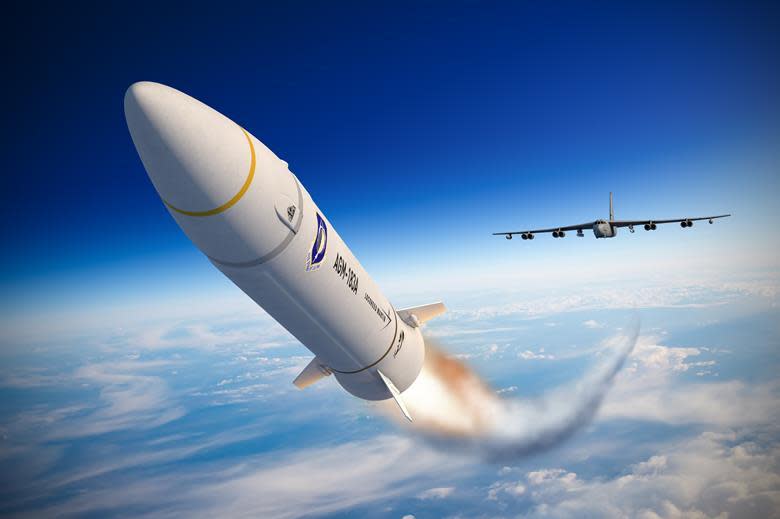Fourth time's the charm: Eglin AFB office announces first successful hypersonic weapon test
EGLIN AFB — After three failed attempts last year, the Air Force Armament Directorate at Eglin Air Force Base has announced the successful launch of an Air-Launched Rapid Response Weapon (ARRW), a hypersonic missile under development by the Air Force with aerospace and defense contractor Lockheed Martin.
Hypersonic weapons, which can fly at multiple times the speed of sound and are difficult to defend against, are the latest frontier in weapons development.
The United States is behind both Russia and China in hypersonic weapons development. The two countries are identified in current U.S. defense strategy as major challenges in a "great power" environment as the United States moves away from its counterterrorism-focused defense strategy of the past two decades.

Missile fizzle: Eglin-connected hypersonic weapon again fails testing
'This is why we test': One win, one setback in recent Eglin AFB-connected weapons tests
Russia and China already have successful hypersonic weapons. In August of last year, China tested a hypersonic missile that circled the globe before honing in on its target. More recently, Russia has fired multiple hypersonic missiles into Ukraine as part of its invasion of that country.
The ARRW is one of seven hypersonic missile projects currently being pursued by the U.S. military services. One of those projects, the Hypersonic Air-Breathing Weapon Concept (HAWC) being developed by the Air Force and the Defense Advanced Research Projects Agency with contractors Lockheed Martin and Aerojet Rocketdyne, completed a successful test flight last month. The HAWC uses different propulsion technology than is employed by the ARRW.
The ARRW is one of seven hypersonic missile development projects currently being pursued by the U.S. military services. One of those projects, the Hypersonic Air-Breathing Weapon Concept (HAWC) being developed by the Air Force and the Defense Advanced Research Projects Agency with contractors Lockheed Martin and Aerojet Rocketdyne, completed a successful test flight last month. The HAWC uses different propulsion technology than is employed by the ARRW.
The successful ARRW test, conducted Saturday over a military test range off the coast of Southern California, was touted by Brig. Gen. Heath Collins, Air Force Program Executive Officer for Weapons and director of the Air Force Armament Directorate at Eglin, as "a major accomplishment by the ARRW team, for the weapons enterprise and our Air Force.”
Collins acknowledged the recent difficulties in the service's ARRW development effort, saying the test team's "tenacity, expertise, and commitment were key in overcoming the past year's challenges to get us to the recent success."
Collins added that the Air Force is "ready to build on what we've learned and continue moving hypersonics forward.”
The 419th Flight Test Squadron and the Global Power Bomber Combined Test Force (GPBCTF), both at Edwards Air Force Base in California, executed the test. Like Collins, Lt. Col. Michael Jungquist, commander of the 419th Flight Test Squadron and director of the GPBCTF, credited the test team and noted the progress signified by the successful test in the Air Force hypersonics development initiative.
"Our highly skilled team made history on this first air-launched hypersonic weapon," Jungquist said in the news release. "We're doing everything we can to get this game-changing weapon to the warfighter as soon as possible."
The Air Force news release included just a two-sentence description of the test, noting only that a "U.S. Air Force B-52H Stratofortress successfully released an AGM-183A Air-launched Rapid Response Weapon, or ARRW, off the Southern California coast, May 14. Following separation from the aircraft, the ARRW’s booster ignited and burned for expected duration, achieving hypersonic speeds five times greater than the speed of sound."
At sea level, the speed of sound is 761 mph, but that speed slows with altitude, and is 660 mph at 29,000 feet, the typical cruising altitude for a commercial passenger jet.

According to Lockheed Martin, the successful Saturday test demonstrated the ARRW's "ability to reach and withstand operational hypersonic speeds" while also providing "crucial data for use in further flight tests." The successful test also validated the ability of the weapon to safely separate from its host aircraft and "deliver the glide body and warhead to designated targets from significant standoff distances," according to Lockheed Martin.
Lockheed Martin said that additional booster test flights and all-up-round test flights (an all-up round is a fully assembled weapon delivered for use) will continue throughout this year. Early operational capability, the first point at which a weapon is sent to an operational military unit, should come sometime in 2023.
Lockheed Martin Missile and Fire Control was awarded a $998 million contract in 2019 for design review, testing and production readiness support for the hypersonic ARRW.
Saturday's successful test of the AGM-183A Air-Launched Rapid Response Weapon came almost exactly five months after the last in a series of 2021 test failures. In a Dec. 15 test, what the Air Force subsequently called an "unknown issue" prompted the launch sequence for a rocket booster mounted on a B-52 to be aborted.
At that time, the Air Force said an analysis of the telemetry and other onboard data from the missile would be conducted, and the ARRW program would "... seek to resume flight test(ing) as soon as possible."
This article originally appeared on Northwest Florida Daily News: Eglin AFB announces first successful hypersonic weapon test

